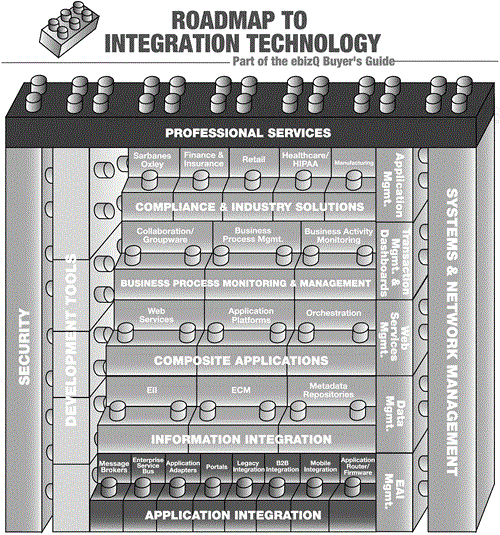Part III of the book focuses on implementing different types of integration solutions. With so many different types of integration technologies to choose from, it is extremely difficult and confusing to understand what is needed to implement a specific integration solution. Part III provides reference architectures for each type of solution. Using the reference architecture as a starting point, you can then more quickly evaluate the most appropriate alternative solutions.
A comparison of all the reference architectures reveals a great deal of overlap among them. Companies will maximize their return on infrastructure investment by minimizing redundancy of integration technologies and services.
The ebizQ Roadmap to Integration Technology was used as the model for defining types of integration solutions. The Roadmap is part of the ebizQ Buyer's Guide that includes a vendor directory organized by map categories.
Each type of solution on the roadmap represents a chapter in Part III. Each chapter contains reference architectures and best practices. Readers of this book looking for vendor solutions based on the reference architectures should refer to the online Buyers Guide (http://www.ebizQ.net).
Chapter 10—Application Integration
Application Integration includes a broad array of business integration scenarios. The reference architectures included are hub and spoke message broker, Enterprise Service Bus, legacy integration, B2B Integration, Portals, and Mobile Integration. Application integration includes all technologies that might be used to connect disparate applications both inside and outside the firewall, at a messaging level.

Reprinted courtesy of ebizQ.net. All rights reserved.
Chapter 11—Information Integration
Chapter 11 focuses on Information Integration and explains one old and two growing segments of the industry. Extract, transform, and load (ETL) is the workhorse of information integration but is beginning to fall short of the needs of most organizations. ETL is batch oriented and aimed at moving large files between applications for processing. The need for real-time access to information across an enterprise has brought about the emergence of enterprise information integration (EII) and enterprise content management (ECM). This chapter will deal with each of these areas as well as addressing the topics of enterprise metadata management and data aggregation.
Chapter 12—Composite Application Integration
Composite applications combine new functionality with existing data and applications. One of the major benefits of a service-oriented architecture (SOA) is the ability to quickly assemble new composite applications. The infrastructure for composite applications may include both EAI and EII, but because new development is involved, the tools as well as the implementers tend to be different.
Chapter 13—Process-Driven Integration
Process-driven integration provides a business-level approach to integration. Companies seeking to optimize business processes, reduce operational costs, and gain real-time visibility into key performance indicators will be interested in business process management (BPM) software, business activity monitoring (BAM), and collaboration software (also called groupware).
Chapter 14—Conclusion: Best Practices for Enterprise Integration
Large companies are likely to have a wide variety of integration needs. A single complex integration solution may require a combination of integration styles and technologies. To increase business agility while reducing implementation and maintenance costs, companies will need to take a strategic approach to integration, even while implementing tactical solutions. This chapter provides a final look at the completely integrated enterprise.
